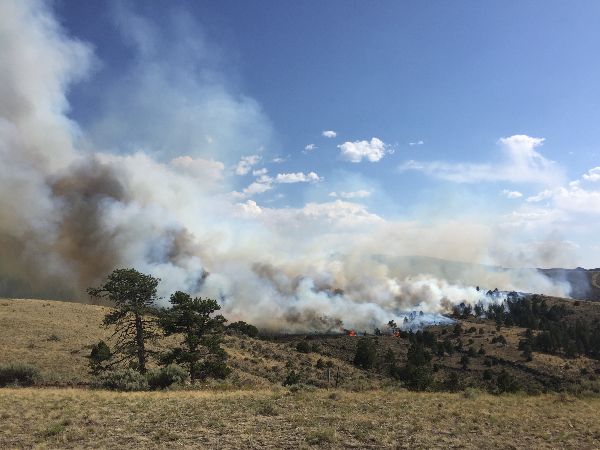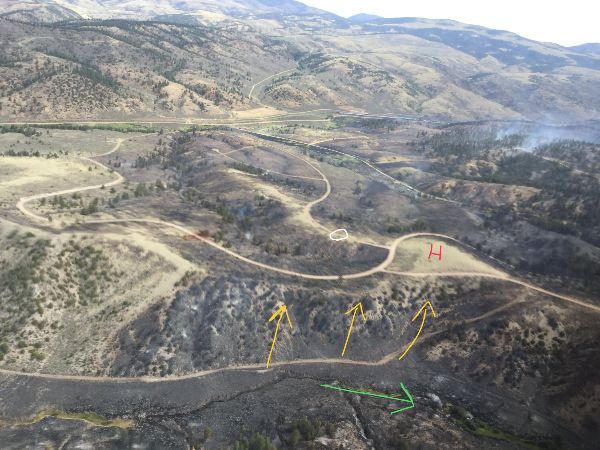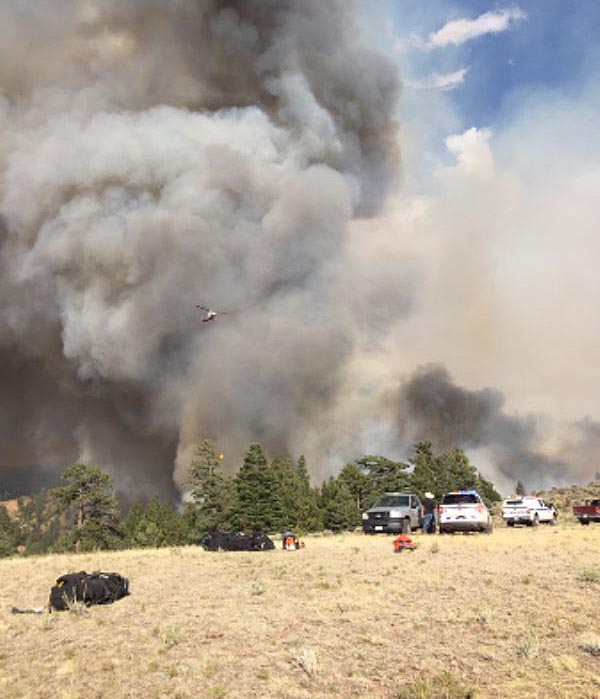
(Originally published at 9:28 a.m. MDT August 20, 2018)
While researching another topic I ran across a preliminary report about a helitack crew that on July 1, 2018 was extracted by their helicopter after the wind changed on the fire, driving it toward their helispot. This occurred on the Spring Creek Fire in Colorado. Because of the timing of the events and since they had to quickly move 150 yards to another location as dense smoke made it unsafe for the helicopter to land at the helispot, it might be described as a close call. But it appears that the reason the report was written was that the crew decided to leave the water bucket and long line attached as they evacuated in the aircraft. Having passengers in a helicopter with a bucket attached is not consistent with policy.
Below are excerpts from the preliminary report. The photos are also from that document. Our opinion is at the end, following the excerpt.
NARRATIVE
…The HMGB [Helicopter Manager, Single Resource] called pilot and requested him to land and pick up the crew, thinking there was still plenty of time to load bucket, gear and crew members. At the time of radio call the pilot had just dropped water in view of the crew, and was less than thirty seconds from the helispot. Winds continued to increase from 10 to at least 30-35 mph. At this time fire behavior increased dramatically, causing all the vehicles parked near helispot (approximately six or eight) to mobilize as quickly as possible and drive down the road below.
The IC asked the crew face to face if we were all good before he left. The HMGB considered jumping in the vehicles for a ride but quickly decided not to. The Decision was based on the time it would take to physically get into vehicles, the time it was taking for the vehicles to actually get headed down the road, the location of the fire at the time, and not being familiar with the fire experience of the vehicles occupants. HMGB deemed it best for the helitack crew to stick together.
As aircraft approached helispot, the pilot informed crew that there was too much smoke to land, but had another landing zone in sight downslope. The crew grabbed gear and began hiking towards the aircraft’s hovering location approximately one hundred and fifty yards down down slope. Helitack crew arrived at the new landing zone as the helicopter was landing. HMGB and crew began loading gear on the pilots side, and had full intentions of loading bucket and longline, but HMGB noticed pilot signaling to plug in flight helmet. Crew members continued to load gear and HMGB went around nose of aircraft, opened managers door, stood on skid and plugged in flight helmet. Pilot advised that he recommended loading crew and picking up with the longline and bucket attached to get to a safe location. Pilot made decision based on the fires rapid progression from time crew left helispot and hiked down to the second LZ. HMGB took a quick scan of fire and agreed with pilot that we needed to lift ASAP.

HMGB went back to cargo area and told the two crew members to forget the bucket and load up we would lift with the bucket attached and relocate to a safe location. The crew members understood and agreed and loaded up. The HMGB made sure aircraft doors were secure, confirmed everyone was buckled and told pilot we were ready to lift. As aircraft lifted, the longline and bucket were on the managers side of aircraft. The HMGB relayed the status of longline to pilot until it was out of view and in view of the pilot out the bubble window.
As aircraft flew away, the pilot informed air attack exactly what we had done. The air attack understood and relayed that the fire experienced a microburst, and one hundred percent of the fire perimeter had active fire spread.The aircraft flew about one quarter of a mile well below the fires heel, over sage brush and grass fuel model, and found a safe place to land. Once on the ground the pilot informed crew we had plenty of fuel, and to take our time loading bucket. The aircraft departed landing zone and flew back to airport in Alamosa, CO to RON. The manager met with the rest of the crew and notified the crews superintendent. HMGB conducted an AAR, and notification was made up the chain of command in the region and the home base region.

CORRECTIVE ACTION
During the AAR, HMGB commended crew members for their vigilance on the scene of fire. Crew was constantly watching the fires behavior and spread, discussing the wind direction and different options to escape if needed. The black identified as a safety zone had a road going from the helispot up past it and was viable until the wind switched and increased pushing the fire up towards the road edge. The crew identified the helispot’s lack of burnable fuel and deemed it a safe spot. A later flight showed that the helispot did not burn, but when the IC decided to leave the spot, the crew did too. Plus one will never know how much heat was actually funneled over it. There was another open ridge downslope about 500-600 yards with a road leading to it that a helicopter could most likely land. The crew could have gotten a ride down to scout it out before the fire blew up, but that location didn’t have a vantage of the fire.
The crew actively talks with pilot about what to do in emergency situations. The crew had even talked earlier in the week about flying with a longline attached. It was comforting to know that those discussions took place and what to expect and the risk involved. The crew also practices proficiency bucket deployment, and packaging drills almost weekly. (Not with rotors turning) This gives managers and crew members a rough idea of how long it takes to perform these functions in the field. The HMGB on board has worked with the pilot for over eight seasons. The relationship, discussions, and trust built over the years was extremely valuable in the decision made that day.
Colorado DFPC Aviation Unit Chief comments:
Appropriate action taken during the extreme fire conditions and glad there was a positive outcome. Suggest a review of the additional risk decision to fly with the longline and bucket with personnel on board. The cost of a longline and bucket burning up is not worth the additional risk and exposure to employees. This is similar to teaching firefighters to drop their packs prior to deployment of a fire shelter from my perspective.
(end of excerpt from the preliminary report)
Our opinion—
The report clearly outlines the fact that the crew felt they did not have time to package and load the bucket and long line, but there is no mention that they considered disconnecting it and taking off without it, leaving it on the helispot. Surely they did think about it, but the replacement cost if it was destroyed in the fire may have been a concern.
I support breaking the rules if there is an urgent, critical need to do so, and if all of the alternatives and possible outcomes are considered. Especially if a person’s life is threatened.
In 2012 a firefighter on the Pole Fire in Oregon was rescued from an advancing wildfire by climbing into a water bucket below a helicopter. The firefighter very reluctantly got into the bucket only after repeated warnings from the pilot that the fire was approaching and he was in immediate danger.
In 2014 on the King Fire east of Placerville, California when a hand crew was in danger of being overrun by flames a helicopter pilot considered using his bucket to extract the personnel. However, he continued to communicate with the crew and escorted them to safety as they walked and ran a considerable distance, orbiting over them and providing constant updates. The whole time he had water in his bucket saving it in case there was a need to protect the crew.

Good planning, crew training, experience, skills and a superb set of decisions by all involved. In my years of helicopter work of faced similar situations. As I told one armchair critic, we, the pilot and myself would have never attempted it if we felt there was undue risk. Sure we broke a couple of rules but we removed the firefighters from a precarious and dangerous situation that was no fault of their own.
Roberto gets the aviation post of the year award.
A weather burst may give no warning. A pilot barely has time to say “Danm! We just got hit!” and from three seconds ago, any flying is corrective at best. Hauling that bucket doesn’t make the bird fly any better. IMHO, I’d rather be extricated without the bucket, but I’ll defer 100% of my own worry to the Pilot In Command. As long as he gets away with it he’s the hero.
If in some big way he doesn’t get away with it, there is not much else the brass can do to him.
There are big differences between real hazards and apparent hazards. It’s his call.
Good pilots know the difference. In the apparent grey areas, they must be allowed to decide.
They say there are no “old bold pilots.” But without a certain amount of courage, that pilot would not have been anywhere near that fire and the crew would be stuck on the ground. Some of those old Military pilots gotta have balls of iron. They are not delivering valentines. There are people on the ground who are determined to drop them out of the sky in a hard way*. Win, lose, or draw, nobody in their right mind will second-guess them.
In this case, everybody’s right. All options are defensible. They are all fraught with unintended consequences. *Any further desired office-outcome can be seen in the arguments being made, either for or against the pilot’s decision. (These are the ground fire which this pilot must navigate.)
In the worst case scenario, it’s always his fireball, not theirs.
Decent weather, successful missions and safe landings, Friend.
Sounds very much like some sound tactical thought and action. I understand the rationale of dropping the bucket, and the pilot could have jettisoned it had there been an issue during the extraction, but despite the weight, it did allow options that wouldn’t have been available; the most important option was time. From another perspective, had the fire advanced and threatened or compromised the extraction due to taking the time to drop the bucket, it would be far worse.
This is one of those times when discussion is beneficial, but the most important decision making took place real time, and had been previously discussed and briefed as an abnormal or emergency procedure. I say good job.